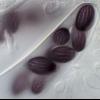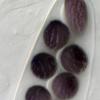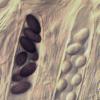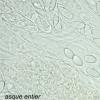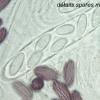
21-12-2025 09:32
Hello.A tiny ascomycete found embedded in wood in

21-12-2025 21:32
Pol DebaenstHello, Garden, Burgweg 19, Veurne, BelgiumOn 10/1

22-12-2025 23:38
Patrice TANCHAUDBonsoir, récolte sur un mur en pierre, apothéci

22-12-2025 00:47
Patrice TANCHAUDBonsoir, récolte à proximité du milieu dunaire

21-12-2025 21:40
Isabelle CharissouBonjour, j'aimerais connaitre les références de

20-12-2025 23:08
Patrice TANCHAUDBonsoir, récolte sur sol sablonneux dans l'arri�
Ascobolus spores question
Chris Yeates,
28-03-2015 20:42
 Bonsoir à tous
Bonsoir à touswhile studying ascospore ornamention in a collection of Ascobolus furfuraceus I noticed something which was happening in a considerable number of asci. The ascospores were arranging themselves such that their respective gelatinous sheaths were aligned to form a continuous sinuous connection along their lengths; the accompanying images show what I mean.
I wonder whether others have noticed this phenomenon in this or in other Ascobolus species?
Cordialement
Chris
Hans-Otto Baral,
28-03-2015 20:59

Re : Ascobolus spores question
yeah, this is vital observation! I could imagine that the gel glues the spores together to keep them in a row in the upper part of the ascus, like the tractus also does. But the function of the gel is probably more that the spores attach to grass leaves.
Chris Yeates,
09-04-2015 23:00

Re : Ascobolus spores question
I have made some more observations on the spore development, and fairly often a very regular arrangement can appear. The key factor is that one needs to be able to see the spores from exactly the right position; in the image below these spores would appear random from a different viewpoint.
Van Brummelen says:
"ARRANGEMENT OF ASCOSPORES. — In Ascobolus the spores are mutually free.
At first they are usually arranged in a single row . But when the ascus stretches there
often becomes space available for a double row of longitudinally disposed spores or
a single row of obliquely disposed ones. Sometimes the very thick, mucilaginous
substance adhering to the spores prevents the formation of a double row . . . .
. . . . . The spores are never regularly arranged, according to a fixed pattern,
in Ascobolus." [my underlining].
To be fair I think he intends to stress the difference in which the spore-balls of Saccobolus follow a very strict pattern (or rather patterns), consistent within a species, as they are formed.
I agree that this is a secondary character and that the true function of the gel is as Zotto suggests.
regards
Chris
Van Brummelen says:
"ARRANGEMENT OF ASCOSPORES. — In Ascobolus the spores are mutually free.
At first they are usually arranged in a single row . But when the ascus stretches there
often becomes space available for a double row of longitudinally disposed spores or
a single row of obliquely disposed ones. Sometimes the very thick, mucilaginous
substance adhering to the spores prevents the formation of a double row . . . .
. . . . . The spores are never regularly arranged, according to a fixed pattern,
in Ascobolus." [my underlining].
To be fair I think he intends to stress the difference in which the spore-balls of Saccobolus follow a very strict pattern (or rather patterns), consistent within a species, as they are formed.
I agree that this is a secondary character and that the true function of the gel is as Zotto suggests.
regards
Chris
Hans-Otto Baral,
10-04-2015 07:35

Re : Ascobolus spores question
I am not sure how Joop was aware of the differences between living and dead. When he speaks of irregular spore arrangements in Ascobolus, he might have included dead asci. In Saccobolus it makes no difference, the arrangement does not change in the dead ascus.
Michel Delpont,
10-04-2015 11:44

Re : Ascobolus spores question
Hello to you both.
I also found this trait on other species such as Ascobolus Ascobolus saccariferus. As against this character is not always present because often the spores are not ordered in the asci and are also not mature. This character is also I think in some asci ephemeral and persistent in others.
Regards.
Michel.
Hans-Otto Baral,
10-04-2015 14:35

Re : Ascobolus spores question
Hi Michel
the arrangement in the living immature asci on your two pics i would estimate as rather regular. The middle of the three immature asci on pic 1 is turgorless, irreversibly as I think. The gel sheath usually inflates when the turor is released but it has a semipermeable membrane and could keep the shape for a while. Your asci with mature spores are all dead, therefore the arrangement is more variable.
the arrangement in the living immature asci on your two pics i would estimate as rather regular. The middle of the three immature asci on pic 1 is turgorless, irreversibly as I think. The gel sheath usually inflates when the turor is released but it has a semipermeable membrane and could keep the shape for a while. Your asci with mature spores are all dead, therefore the arrangement is more variable.

